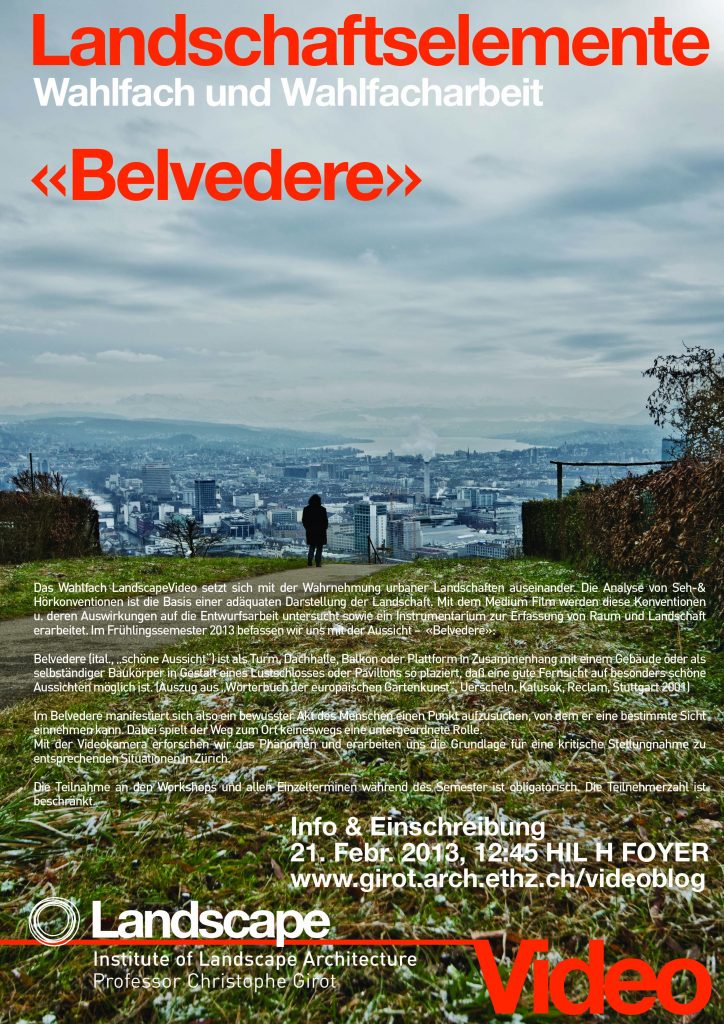
ABSTRACT
The elective course examined the “Belvedere” as element of the urban landscape.
TEACHING TEAM
Prof. Christophe Girot, Susanne Hofer, Johannes Rebsamen
STUDENTS
Basil Bolliger, Carla Häni, Laura Hänni, Lennart Harbich, Stefan Hasler, Nina Hug, Stephie Pfenninger, Dominik Thurnherr
CONTACT
Investigating the Landscape Element Belvedere in the City
The elective course (Wahlfach) and the thesis (Wahlfacharbeit) of the coming term will examine the “Belvedere” as element of the urban landscape. With the creation of the Belvedere man demonstrates an intentional act to visit a place with a specific scenic view. Within this act not only the view is of importance but the journey towards. How can we summon and translate the things we hear, see, smell and feel – in brief our aesthetic experience – in a filmic montage?
Belvedere – ‘A usually rounded natural elevation of land lower than a mountain. An artificial heap or mound’ (Webster). Most natural hills found in the Low Countries were formed by glaciers or strong winds, and range from linear coastal dunes to circular Pleistocene dunes and ridges. Their limited numbers make them stand out as landmarks, from which one can view the horizon in a flat Iandscape (Higuchi 1983). (“LEXICON OF GARDEN AND LANDSCAPE ARCHITECTURE”, Meto J. Vroom, Birkhäuser, Basel 2006)
With the creation of the Belvedere man demonstrates an intentional act to visit a place with a specific scenic view. Within this act not only the view is of importance but the journey towards. Belvedere – translated from the italian words bel/bello, beautiful and vedere, the verb to view, Belvedere means the beautiful view.
The introduction of our elective course into the topic started not only with the quote out of a lexicon and the etymological translation of the word, but with the question who nowadays is reaching for the most intense view. As a swiss citizen and living not far to the alps, my thinking was led to the swiss alpinist Ueli Steck, who climbs the Eiger-Nordwand in two hours and 47 minutes without a rope – not only to gain the perfect view of the alps but still feeling his own heartbeat jumping, his view should be doubled in intensity.
Comparing Steck’s interviews out of the book “solo”, published 2006, with Francesco Petrarca’s description of the climbing of the Mont Ventoux in his letter to a friend in 1336, at one point it was obvious that the two have not been looking for complete different satisfaction.
Student Work ‘Sky Fishing’: Lennart Harbich
Student Work ‘Viervedere’: Laura Hänni, Nina Hug
Student Work ’24h Belvedere’: Carla Häni, Dominik Thurnherr
Student Work ‘Longitudinal’: Stefan Hasler, Stephie Pfenninger
Student Work ‘Panorama’: Stefan Hasler, Stephie Pfenninger
Student Work ‘Unter der Brücke’: Stefan Hasler, Stephie Pfenninger

